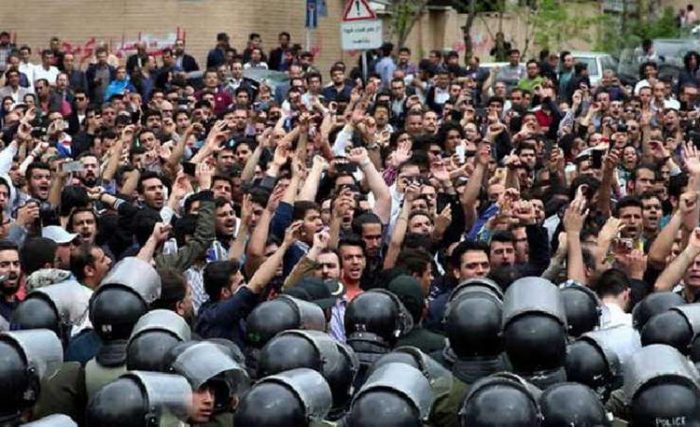
Archive Photo- The Iranian regime security forces attack protesters during a demonstration – January 2018
Our Iran released their annual report on the Iranian opposition movement in Iran. The report chronicled the 9,596 protests that took place in Iran’s 31 provinces between December 2017 to December 2018, mainly reported by the MEK sources inside Iran.
⚡️ Social Media campaign calls for the immediate release of those arrested in nationwide protests in Iran using hashtag #FreeAllProtesters by sharing a photo with a victory sign representing the picture which emerged last week from the protests in #Iran
by @MEK_Iran #MEK pic.twitter.com/a4oAh2vzXX— MEK Iran (Mujahedin-e Khalq) (@MEK_Iran) August 15, 2018
Common Themes
The Our Iran report noted that in the time period, the protests followed similar patterns that characterized the nature of the movement. Each time, people’s protests began “with guild claims [then] quickly turned into political demands and slogans against the entire sovereignty.”
Secondly, in each instance, the solidarity the Iranian public expressed with the protestors of each strike, protest, and the march was astounding. No matter whether it was striking truck drivers, merchants, steelworkers, teachers, students, sugar cane workers, pensioners, or investors, the Iranian public, particularly Iran’s youth, and women, turned out in support of the protesting workers.
They shouted slogans like “don’t be afraid, don’t be afraid, we are all together”, showing their support for the striking population.
The internet also played a vital role in the 2018 protest movement. The Iranian opposition and the People’s Mujahedin Organization of Iran (MEK) used the web and social media to coordinate protests and mobilize the Iranian public.
Khamenei Breaks His Silence on Recent Protests in #Iran https://t.co/gdtDHgxjtP#MEK#FreeIran2018#IranProtests
— MEK Iran (Mujahedin-e Khalq) (@MEK_Iran) June 7, 2018
Through these tools, the MEK was able to get all demographics and classes of Iranian society to join their cause, from urban elites and middle classes to working-class factory workers, and rural farmers. The 2018 protests saw every strand of Iranian society represented in the faces of those in the streets carrying signs and shouting slogans.
A Timeline of Iran’s 2018 Protest Movement
The protest movement was ignited by a nationwide protest movement at the end of December 2017 and the beginning of January 2018.
A recent report mainly based on reports from the Mujahedin-e-Khalq (#MEK) network inside Iran, indicates that there were a total of 452 #protests and gatherings last month in #Iran, averaging 15 per day.https://t.co/QoUbcCkQXJ pic.twitter.com/Rj2XQGU66I
— MEK Iran (Mujahedin-e Khalq) (@MEK_Iran) May 11, 2018

Credit to Iran News Wire: 2018 Iran protests at a glance
Very quickly, protests erupted across 142 cities and towns in all 31 of Iran’s provinces. In Mashhad, 10,000 people turned out in front of the city’s municipal building. Similar sights were suddenly commonplace across Iran.
As a result, January saw 643 protests, and this momentum was carried into February, which saw 596 protests.
However, the movement peaked later in the year. In October, Our Iran recorded 1,533 distinct protests that broke out in Iran, up from 1,367 in September.
This was largely due to Iran’s striking truck drivers, who turned out for their third round of strikes in September. The logistics sector and Iranian truck drivers went on strike once more, spread across 323 cities.
In 2018, striking truck drivers were behind the most protests. In total, truck drivers held 3,868 protests, slightly more than the country’s workers which held 1,933 protests. Teachers and retirees were next, holding 683 protests.
All in all, there were a total of 26 different protests a day across the country. The mullahs and the Supreme Leader Khamenei are under intense pressure.
The Regime Response
These protests have showed made one thing abundantly clear; the Iranian regime is weaker than it has ever been. It has exposed itself as utterly unequipped to deal with the scale of the Iranian opposition movement.
They have not succeeded in ending the uprisings. If anything, their heavy-handed, repressive response have only made the public angrier and more determined to overthrow their oppressors.
https://mek-iran.com/wp-content/uploads/2018/09/A-political-scientists-view-on-the-Iran-protests-750-e1536427588296.jpg
The clerical regime has threatened the strikers, brought in plainclothes security agents to control protestors, made false promises, attempted to play protestors off against each other, then alluded to execution for those involved.
They abducted protestors in the middle of the night, tortured people in regime custody, and others were killed by anti-insurgency forces at the scene of the protests.
These brave protestors will not have died in vain. 2019 will be pivotal to the protest movement and the fight to usher in a new era of Iranian democracy. If 2018 is anything to go by, it will be a monumental victory for the MEK and the Iranian public.
Staff Writer
